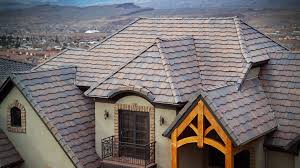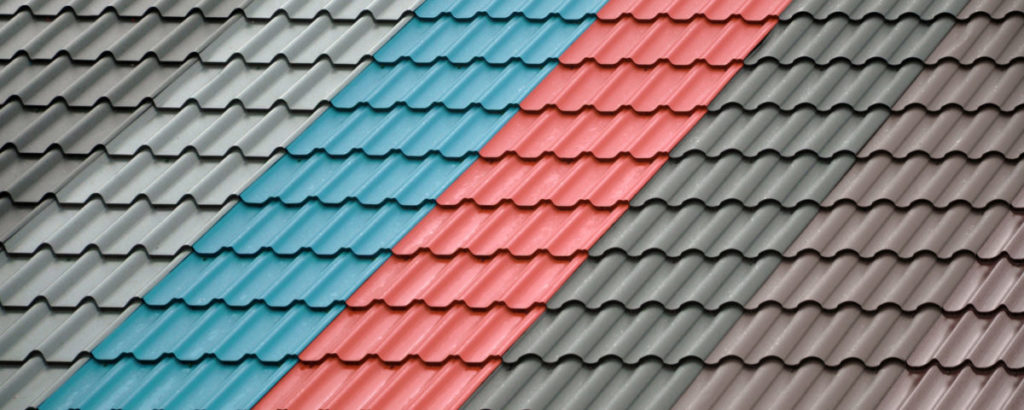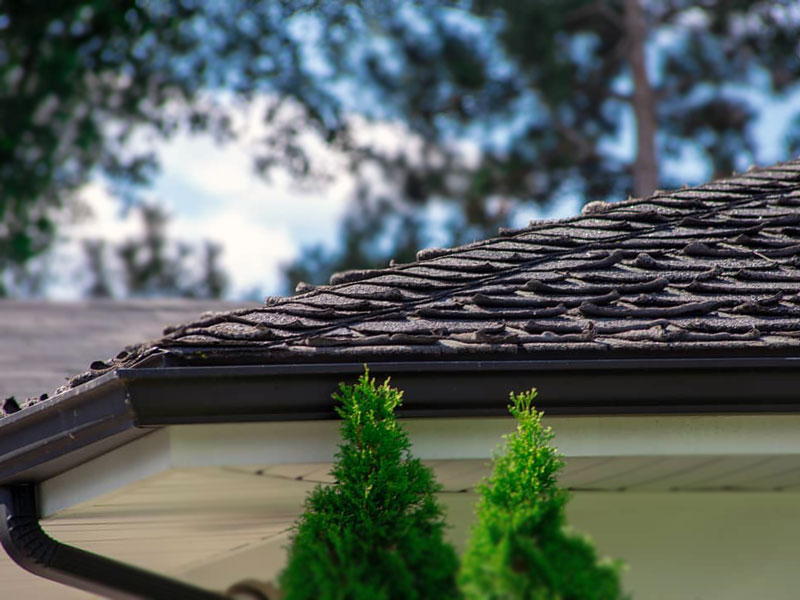Types of Tile Roofing
What Are the Main Types of Roofing Tiles?
Once you know the factors to consider, it is time to make a decision. Consider all the available choices of roofing tiles. Here are the main roofing tiles.
Metal Tiles
Metal tiles are similar to metal roofs in that they share most of the advantages. These include longevity, very few leaks, and durability. The upside to using metal tiles as opposed to metal roofs is that metal tiles have more styles to choose from.
Nowadays, metal tiles can be fabricated to look like slate tiles, clay tiles, and several other roofing tiles. They are then applied an acrylic coating to protect and enhance the look. Such tiles are suitable for homeowners who are not looking to add reinforcements to their roof decks.
This is because metal tiles are lighter than concrete tiles but thicker than asphalt shingles.
Copper Tiles
Copper roofs are known to last for more than a century before they need to be replaced. Copper tiles offer the same durability as copper roofs but they are more versatile which makes compatible with different roof styles. The biggest downside to using copper tiles is that they require professionals to install.
They are also expensive to maintain.
Stone Tiles
Slate tiles have been around for centuries primarily due to their longevity and pleasant colors. They can last up to 100 years. They also have a unique color variation that adds a pleasant look to a building.
Slate tiles are expensive and difficult to install which is one of the reasons that homeowners prefer to avoid them. Finding an experienced roofer to install the slate tiles will also be a problem. However, the authentic look you get from these tiles is worth the hustle.
Ceramic Tiles
Ceramic tiles are known for their fireproofing abilities and to some extent their durability. They exclusively used in Southwestern and Spanish style homes but now they are almost everywhere. They come in different shapes, sizes, and colors which makes them ideal for a wide range of homes.
Polymer-Sand Tiles
Polymer-sand tiles are made from mixing sand and binding them with polymers. They are considered to be the most suitable alternative to the use of ceramic tiles. They look similar to ceramic tiles but they are more durable and less likely to break.
Once installed, polymer-sand tiles require very little maintenance or replacements.
Similar to ceramic tiles, polymer-sand tiles are fireproof and weigh less than slate tiles and concrete tile. Your options regarding size and color will be limited to just a few since the number of polymer-sand tile manufacturers is still small.
Composite Tiles
Composite tile roofing is a multi-layered tile that comprises of acrylic, metal, and stone. The demand for such tiles is soaring as the need for a more natural appearance continues to increase. Composite tiles look similar to slate and clay tiles but are lighter than stone and concrete tile.
This makes them suitable for roofs with the required reinforcement for heavy roofing materials.
Bituminous Tiles
Bituminous tiles are among the lightest and easiest to install. They are made of fiberglass and covered with basalt chips or granite on top. They can be installed by any roofer since they only require an adhesive to fix them to the roof.
This reduces the likelihood of leaks as there are no holes punctured into the roof.
Concrete Tiles
Concrete tiles can be a good alternative to ceramic tiles as they are less prone to breakage and look similar to ceramic tiles. Concrete tiles are made from a mixture of cement, sand, and water. The result is a tile that is very heavy, easy to install and less expensive than slate tiles.
The only downside is that their weight creates the need for reinforcement in some roofs.

Key Factors to Consider When Choosing Roofing Tiles
Are you looking to replace your roof tiles and aren’t sure where to start? When it is time to start or repair your roof, you need to consider what you want before you call a roofing contractor. By making the right decision, you increase your homes visual appearance and its value.
Here are key factors to consider when you make the decision.
1. Style of Your Home
The architectural style of your house will dictate the type of roofing tiles to use. For instance, some roofing tiles are best suited for historic homes while asphalt shingles are suitable for most architectural styles. Consult with your contractor to choose the roofing that matches your home’s aesthetics.
2. Roof Application
Are you applying the roof to a new structure or is it a replacement roof? With new roofs, your choices are not limited to the existing components such as the roof structure composition or the roof pitch.
However, because of the cost of replacing a new roof entirely, if you are replacing a few broken tiles, it would be best if you retained the existing roof.
3. Your Budget
As a roof of thumb, choose a roofing material that is neither too expensive nor too cheap. The price will vary depending on the material. Always avoid cheap roofing materials, as they are costly to maintain due to frequent replacements.
Do not base your decision on price alone.
4. Durability
Your choice on roof tile types should be guided by durability. The durable roof tile will cost more but it will be worth it since the maintenance cost will be low. Most homeowners will prefer steel or aluminum roofing materials as they can last up to 50 years or more.
If that doesn’t work for you, you can always opt for the slate which can last for more than a century.
5. Climate
How is the climate in your locale? Your roof should be sturdy enough to withstand even the most extreme temperatures in your area. For example, if your locale is predominantly hot, refrain from using rubber material instead choose asphalt shingles.
Areas that have high precipitation can try metal roofs as they are waterproof and rust resistant.
6. Energy Efficiency
Be sure not to pick a roofing material that will require you to spend more on energy costs. Preferably, choose a material that is energy efficient. This will reduce your energy costs.

Longest Lasting Roofing Material
The NAHB (National Association of Home Builders) rates slate as by far the longest lasting roofing material, with a life expectancy of 150+ years, followed closely by clay and concrete at roughly 100 years. This would seem to make them the ideal choice if you’re planning a home to last for generations but there are drawbacks to these materials that you will need to consider:
- First, there’s the cost. These are premium materials and they come at premium prices. With such a long life expectancy, they’ll provide value for money in the long term but the initial outlay is extremely high.
- Another problem is weight. All these materials are heavier than the alternatives and require very strong support, adding to the cost of construction. This is particularly true for slate, which is, after all, solid stone.
- Finally, there are aesthetic considerations. With clay tiles and concrete, your choice of color and appearance are very limited. With slate, it’s reduced to choosing between shades of grey. This can look very elegant on the right building in the right setting but would look extremely out-of-place on most suburban homes.
So although clay, concrete, and slate are the most durable roofing materials, they might not necessarily right for you.

What Type of Roofing Materials Last the Longest?
Asphalt Shingles
One of the most common and popular roofing materials, asphalt shingle roofing is highly favored because of how cost-effective it is without compromising protection. It can safeguard your home against wind-driven rain, snow loads and even hail storms.
Metal
The metal used in roofs has plenty of benefits such as energy efficiency, wind resistance and fire resistance. It’s a great choice for homeowners who prefer a quick and painless installation. Plus, most metal roofing systems are eco-friendly, highly recyclable and last longer than asphalt shingle roofs.
Clay Tile
The great characteristic of clay tiles is how they maintain their traditional beauty despite their long service life of up to 100 years. That said, you should pair it with an efficient gutter system for better drainage and, consequently, less risk of water damage.
Wood Shake
Wood shake shingles are thicker than wood shingles because they are hand-cut rather than machine-made. Wood is a natural insulator, stabilizing your interior from the outset without resorting to add-ons. With an impressive life span of up to 40 years with proper maintenance, wood shakes are prime candidates for the best-looking roofs you’ll ever have.
Slate
You may have seen a slate roof more than once because it’s a highly popular roofing material among historic buildings. This is thanks to slate’s longevity and durability. Today, it lives up to its reputation by combining traditional beauty and enhanced protection to make an acceptable compromise between cost and near-permanence.
Weighing Your Options: Metal or Tile Roofing
Choosing a roof for your home, be it metal or tile, is really a personal preference. However, you cannot ignore important factors in deciding which material will most likely work best. These factors include your location, the climate conditions in your area, and your budget. Fortunately, many diverse styles and types of roofing materials are available today.
The two main types of roofing materials are metal and tiles. To help you weigh things up, here are some pros and cons about the two:
- In terms of durability and resistance, a concrete tile roof is proven to outperform other roofing products. It has a lifespan of up to 50 years, compared to metal roofing of 30 to 45 years. Concrete tiles can withstand the toughest elements. Environmental conditions, however, affect metal roofing. For instance, metal roof tends to rust with exposure to salt and temperature changes, among others. Metal roofs are also more prone to dents and cracks if there is weight on them, as compared to concrete tiles.
- Both metal and concrete roof tiles have advantages when it comes to energy efficiency. Of the two, however, concrete roof tile contributes more to controlling internal temperatures, thereby reducing energy consumption.
- In terms of design and style, both tile and metal roofing has evolved through the years. Although, metal roofs have more advantage in this area as they look better with any architectural style. The choice of your design could also have an impact to the aesthetic appeal and resale value of a property. It is estimated that the recouped value of a metal roof resale is approximately 90%.
- Turning to maintenance, the colour of metal roofs normally dulls after a couple of years. Repair of metal roofing can also be difficult and expensive. This is because the entire sheet of the metal roofing may have to be removed. With concrete roof tiles, however, you can always find a set that will match the existing colour of the roof tile that has to be replaced.
- In terms of costs, installing metal roofing requires high level of skills and technical expertise. Therefore, installation costs are usually higher.
So, the next time you change your roof, look for that solution that is appropriate to your home’s location, appealing enough to suit your style, and will give the best value for money.